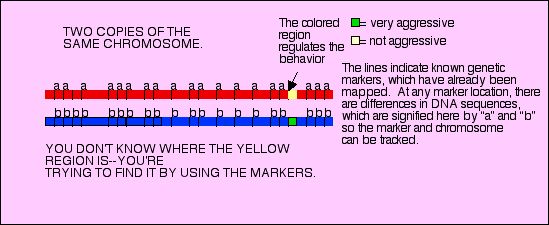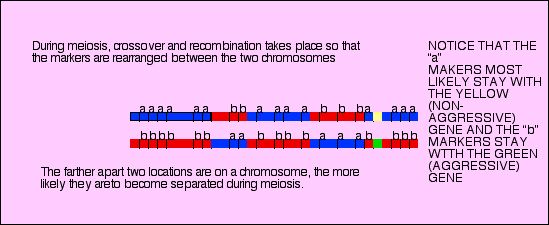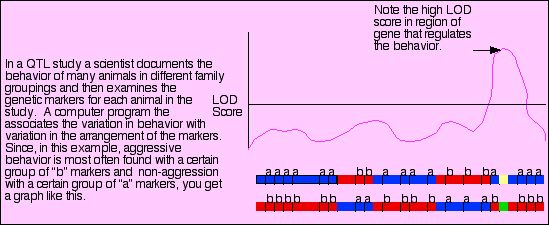
Quantitative trait loci (QTL's)
A quantitatively inherited trait is one which is determined by a number genes acting together. A good example is height in humans; how tall a person grows is greatly influenced by genes, but no one gene is solely responsible for height. Quantitative traits vary continuously along a measurement scale, and are often well-described by a normal (bell-shaped) curve. It follows that a QTL, or quantitative trait locus, is a location on a chromosome which is thought to regulate an organism's phenotype for quantitative trait
Many behaviors are quantitative traits. Aggressiveness, for example, varies among individuals in types of animals, such as honey bees, rodents, horses, dogs, and various primates. Another good example is expression of play behavior in mammals. Intelligence, to the extent that it can be measured, is also a quantitative trait.
The following questions are usually addressed in a QTL analysis:
In order to perform a QTL analysis, a animal behaviorist needs two critical sets of information. First, there must be a linkage map of the genome of the study species. Second, there must be a good method available to measure how the behavior varies among animals. All that remains is to do a breeding experiment. Typically animals whose behavior has been measured and which have been genotyped are mated. The behavior and genotypes of their offspring are then determined, as well. There are other experimental approaches which will give the same result, but all QTL analyses rely on a linkage map and good behavioral measures.
To visualize how the data are analyzed, think of a chromosome, remembering that in most animal's chromosomes come in pairs. The scientist has genetic markers (short sequences of DNA) scattered along the chromosome; at a given location, the DNA sequences of these markers vary between the two copies of the chromosome. During meiosis the two members of the chromosome pair crossover and segments of the chromosomes are exchanged, resulting in genetic recombination.

Think of a two different markers along the chromosome. MOST IMPORTANTLY, the chances of recombination occurring are high if the markers are far apart, and low if the markers are close together. Now what do you think happens to genes that regulate behavior? If they are close to a marker, they likely stay linked with that marker during recombination. If they are far from a marker, then they are much less likely to stay linked.

Using a rather elaborate computer program, the scientist can ask whether the
variation in behavior is correlated with each marker. Looking within one family
in the breeding experiment (a male, female and their offspring), if the behavior
is always high with a certain sequence of a marker and always low with another
sequence, then probably the gene for the behavior is close to the marker on
the chromosome. If the variation in the behavior is more or less random in relation
to the marker, then there is little or no linkage between the behavior and that
chromosomal location. The level of association between behavior and location
is called an "LOD" score.
Most quantitative traits, including behavioral traits, have high LOD scores for from two to four locations in an organism's genome. There are, of course, exceptions to this, but this is a good rule of thumb. The higher the LOD score, the more "important" a gene may be in regulating the behavior. These chromosomal locations probably do no code directly for a particular behavior, but instead for factors which shape the behavior. For example, a behavioral trait may be influenced by three genes, one of of which affects activity (or arousal), another sensory perception, and the third latency to respond to a stimulus.
What does knowing the locations of QTL's do for us? If we were working with domestic animals and wanted to select for certain behavioral traits, knowing the QTL's would allow us to design an efficient breeding design to achieve the desired result. This hasn't actually been done in animals, but the principle is commonly applied in crop plants. By knowing which chromosomal locations are important, scientists can, conceivably, track how their genetic manipulations are affecting the regulation of the trait.
The other possible outcome of locating a QTL is actually being able to determine what the identity is of the gene that is influencing the behavior. The problem here is that the QTL location is not precisely known--the data only show that it is between two markers. Molecular geneticists can overcome this problem by sequencing the chromosome from the two markers ("upstream" from one, "downstream" from the other). If the distance between the two markers is not too large, then this is technically possible. By comparing the DNA sequences with sequences of known genes, the identity of the genes between the markers may be determined. The scientist can then form a hypothesis about which of the genes in the QTL region has the behavioral effect.
Boake CRB, Arnold SJ, Breden F, Meffert LM, Ritchie MG, Taylor BJ, Wolf JB, Moore AJ 2002 Genetic tools for studying adaptation and the evolution of behavior AMERICAN NATURALIST 160: S143-S159 Suppl. S
Flint J 2003 Analysis of quantitative trait loci that influence animal behavior
JOURNAL OF NEUROBIOLOGY
54 (1): 46-77
Gershenfeld H. K., Neumann P. E., Mathis C., Crawley J. N., Li X. H., Paul S. M. 1997. Mapping quantitative trait loci for open-field behavior in mice. Behavior Genetics 27: (3) 201-210
Gleason JM, Nuzhdin SV, Ritchie MG 2002 Quantitative trait loci affecting
a courtship signal in Drosophila melanogaster
HEREDITY 89: 1-6
Guzman-Novoa E, Hunt GJ, Uribe JL, Smith C, Arechavaleta-Velasco ME 2002 Confirmation of QTL effects and evidence of genetic dominance of honeybee defensive behavior: Results of colony and individual behavioral assays BEHAVIOR GENETICS 32 (2): 95-102.
Hunt G. J., Collins A. M., Rivera R, Page R. E., Guzman-Novoa E. 1999. Quantitative trait loci influencing honeybee alarm pheromone levels. Journal of Heredity 90: (5) 585-589
page 4-*
copyright ©2003 Michael D. Breed, all rights reserved